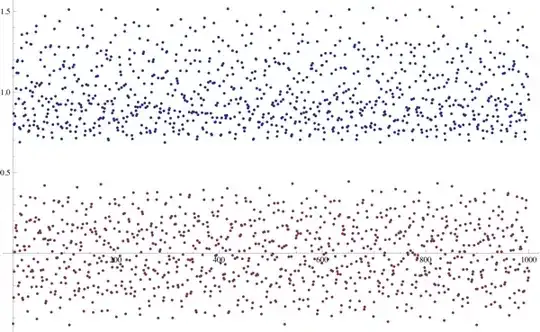Is it true that $$ \lim_{n\to \infty} \zeta(2+ni) =1 ?$$ If not, what is the value of the limit? What about the same but with other real parts other than 2?
-
3Nope. It just oscillates. – Lucian Oct 26 '14 at 13:37
-
It just oscillates? That's interesting... – Asier Calbet Oct 26 '14 at 13:38
-
You may also be interested by this thread with orbits of $;\zeta(\sigma+it);$ for $,\sigma=0, \dfrac 12, 1,\dfrac 32$ (no hope for convergence but rather larger 'diffusion' for fixed values of $\sigma$). – Raymond Manzoni Apr 29 '21 at 09:00
2 Answers
To understand why this limit doesn't exist, let's look at a single term appearing in the sum, namely $$\frac{1}{2^{2+ni}} = \frac{1}{4\cdot 2^{ni}}$$ So all the change occurs in $2^{ni}$. Treating $n$ like a real variable (which you may or may not have meant), this is periodic in $n$. In particular, $2^{ni} = e^{in \log 2}$, so that this is periodic in $n$ with period $2\pi/\log 2$.
Similarly, each other term will be periodic in $n$, but with different periods. So the various periods are a bit weird, but you can now see that the values will oscillate wildly, and not go to $0$.
- 91,687
Expanding the function, we have $$ \zeta(2+ni)=1+\frac{2^{-ni}}{2^2}+\frac{3^{-ni}}{3^2}+\frac{4^{-ni}}{4^2}+\cdots $$ The terms (except the first) circle around the origin, each with smaller distance, but greater frequency. It is hard to show that these terms do not, for some reason, cancel, but there is no reason, that I can think of, to think that they do.
The following plots seem to support the conclusion that there is no cancellation.
Here is a plot of the real and imaginary parts of the first $1000$ terms:

The real part (in blue) is centered on $1$ because of the first term.
Here is a plot of the $1000$ terms in the complex plane:

The vacancy near $1$ is to be expected, but the asymmetry in $x$ is interesting.
- 345,667